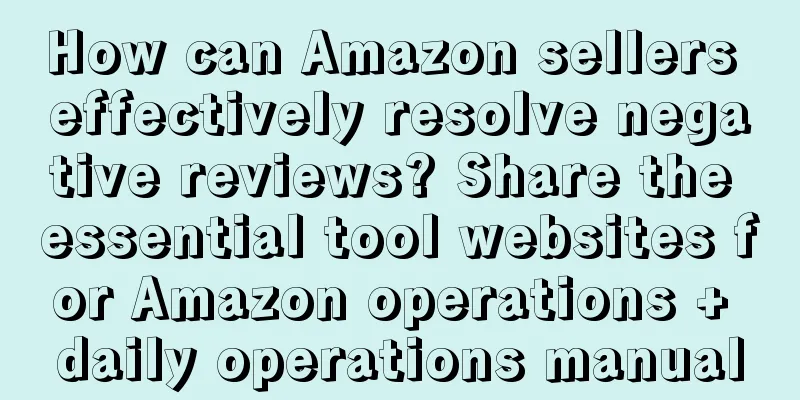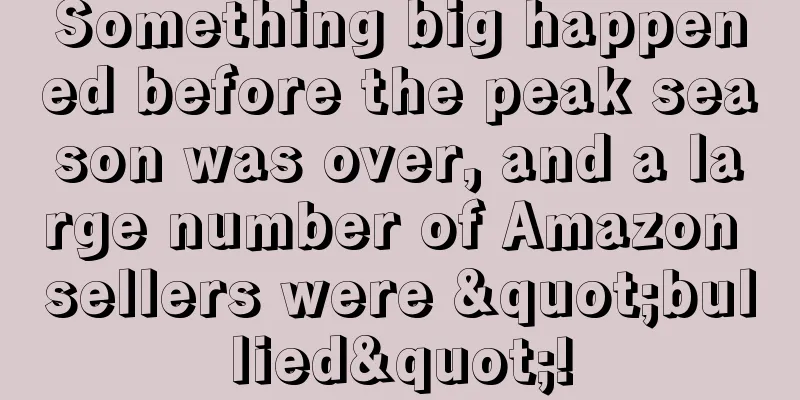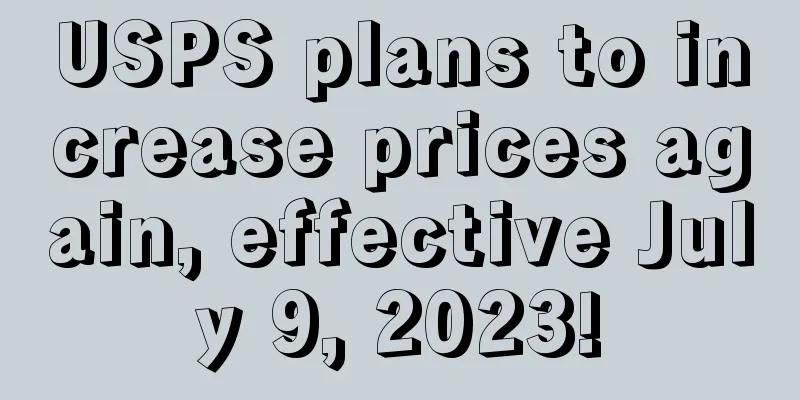What are the Amazon product selection tools? How to use them?

|
There are many product selection tools for Amazon. This article focuses on these three tools: keepa, Jungle Scout, and camelcamelcamel. 1.keepa First of all, let's introduce what Keepa is. Keepa is a free Amazon price tracking tool that saves the price history of all products on Amazon. Keepa is actually a tool for analyzing product sales. By understanding its data, sellers will have a clearer understanding of their competitors' and their own products. Keepa's data tracking system is unique among Amazon's operational tools. Its real-time data updates and product coverage cover almost all ASINs on the Amazon platform. Keepa has even made many similar product selection software popular through its data KPIs. From the perspective of traditional Chinese values, only tools with core data mining capabilities are worthy of high prices. This has also led to the behavior of some domestic product selection software buying data at low prices and selling software at high prices being despised by many senior operators. So, how to install keepa? This plugin can be installed on Chorme and Firefox. The installation steps are: Log in to the official website: https://keepa.com, select a suitable browser on the homepage, and install it with one click (for example, select Firefox, click the icon, then click "Add to Firefox", and then click "OK".) The plug-in is now installed, and you will see the small keepa icon in the upper right corner of the browser. Next, we will introduce the basic functions and data indicators of keepa. Go to the Amazon platform and find the product details page you want to analyze. Below the bullet point, you can see the product-related information displayed by Keepa. 1. Coordinate data Horizontal axis: displays date; Vertical axis (left side): displays price; Vertical axis (right side): displays sales ranking, number of new product sellers, number of reviews, and ratings. 2. Data expansion and closing We can see that there is a gray horizontal line "—" in front of the data indicators on the right. Click the "—" with the left mouse button, and the icon will turn into a colored "o", and the corresponding data will be displayed in the chart; Click "o" again, the icon switches to "—", and the indicator data will disappear from the chart. (For the specific effect, you can see the comparison of the following two pictures). 3. Introduction to data indicators Amazon: This is the price of Amazon’s own products, usually displayed as an orange line. The orange shadow indicates that Amazon's own store is in sales and has inventory; the white blank area indicates that Amazon is out of stock. At this time, we can choose to launch the product online to avoid direct competition with Amazon. NEW (new product) price: refers to the historical price change status of the currently selected product (when the mouse moves over the line, the price of the product at each time point is automatically displayed). There will be a list price indicator later, but when we analyze price changes, we mainly focus on the price displayed by new. Used (not new): This data indicator refers to the historical second-hand price of the product. Sales Rank: This data indicator is the one we need to focus on. It shows the historical sales ranking data of the product. The data on the right side of the vertical axis represents the ranking. This data can be arranged from low to high or from high to low. Just click the arrow chart on the right side of sales rank to switch.
List Price: The price filled in the backend when uploading the product is the manufacturer's suggested retail price. New, 3rd Party FBM: Price for third-party delivery. Lighting Deals: Discounted prices for participating in Amazon Lighting Deals. Warehouse Deals: The price at which Amazon lists returned or exchanged items as used goods. New, 3rd Party FBA: The price of third-party FBA shipments. Buy Box: Get the golden shopping cart. Used, like new/Used, very good/Used, acceptable: This mainly refers to the condition of the second-hand goods. New Offer Count: The current number of new product sellers (actually refers to how many sellers are currently selling this product). Used Offer Count: The current number of sellers that are not new products (how many sellers are selling this product as a non-new product). Rating: The rating of the review. Review Count: The number of reviews. So, in the product selection process, what kind of help will using Keepa provide when you are doing competitive product analysis? 1. Buy box, shopping cart, is a rose-red triangle. Click the opening triangle to see more detailed data, the important data in it is the seller column. If your product is copied in the middle of the night, but you can't find who copied it, click on the buybox, there will be a record. If it is a short-term copy, it will appear that it has not been captured, and the buybox in the background is not 100%. Of course, the buybox missing rate displayed in the background is not only due to the single reason of being copied. 2. Date. This data will only be displayed after registration and login. The data in it is very comprehensive and is very helpful for tracking records of competing products. This data has a certain quota. Each click will consume 10%, and it will slowly recover later. 3. Sales Rank, product sales ranking. You can clearly see the ranking of competing products at each stage. Generally, the product price should be taken into consideration. Price changes will have a certain impact on the ranking of the product. When tracking your competitors over the long term, you can generally choose to track the top 10 products for a major keyword, and you can judge sales and the entire market traffic based on the rankings.
4. Review product reviews. The number of reviews and star ratings are recorded in real time, which triggers some thoughts: Listing review data appears earlier than product price data? Review data increases or decreases dramatically in a short period of time? Take the following products for example: In addition, when there is no change in the competitor's listing, the number of reviews has not increased, and the competitor seems calm, but the ranking is rising rapidly, in addition to a large number of fake orders to increase rankings, there are also some strong sellers who have spent a lot of effort outside the site. At this time, you can use ahrefs to check how many external links your competitor has made, so as to know how much effort the competitor has made behind the scenes, which we can learn from. 5. Tracking of competitor LD. Through this notification, you can get whether your competitors have participated in LD. So what benefits will we get from getting this information?
How can we judge our competitors’ operating methods through Keepa? The easiest way to judge whether a competitor is strong is to see whether he can make a comeback and turn the tide when dealing with a crisis. As shown in the following figure: Judging from the "ups and downs" in the number of comments, it's clear that this opponent is no simple one. He is very good at splitting, merging and changing the rules, and at fake orders. The most important thing is that he can also ensure that the sales ranking will be quickly restored to its original position when the number of comments drops sharply. Either he has rich experience in off-site traffic, or he is familiar with black technology. You can see in this chart that when the number of reviews was halved, the seller ranking dropped rapidly but was pulled back by the sellers and continued to dominate the top rankings. So when we are choosing categories, if most of the competitors ranked in the first three pages of search are such powerful screen-dominating characters, we generally advise sellers to think twice about such categories. Of course, there are still many sellers on Amazon who are very dedicated and focus on making products and marketing. You can find more of these well-known brand sellers to analyze, not only to see the trend changes of products under natural traffic, but also to learn their operating methods. Jungle Scout Jungle Scout can help sellers find Amazon products with great potential through big data, track and monitor competitors’ pricing, inventory, profit margins, etc., thereby helping sellers maximize sales profits. Jungle Scout is a product selection and development tool. In addition, the Jungle Scout tool supports the following sites: Amazon United States, Canada, Mexico, United Kingdom, Spain, India, France, Italy and Germany. Jungle Scout has two versions: Web App and Chrome plug-in: Web App version features:
Get an in-depth understanding of products: Dig deep into products to view prices, monthly sales forecasts, FBA fees, best-selling rankings, etc., and capture information in real time without jumping to the browser. So, how to use these two versions? Web App version: The user interface shows the four main Jungle Scout packages: Click “Add to Tracker” and you will need to wait 48 hours for the data to be available. The data graph will be as follows: Sellers can then filter products based on some indicators and come up with: Through product data charts, sellers can check whether the popularity of the product is on an upward trend, whether other sellers are out of stock, whether the price has been changed recently, etc. All of this information can help sellers find the best product selection strategy. Use of product database: First, select the Amazon site and product category: Then use the filter to filter the products: Finally, click “search” to let Jungle Scout generate the results: Use of Niche/Market Segment Finder: The Niche/Category Finder works similarly to the Product Database, except it generates results based on keywords instead of specific ASINs: First, sellers need to select a site and choose the category they want to focus on. Next, fill in the niche attributes section: Click “search” to receive new niche keywords and related data: Sellers can quickly understand the number of products sold in a specific market and the market competitiveness: Chrome plugin version: To use the Jungle Scout Chrome extension, simply navigate to any page on Amazon. The extension works on the same sites as the web app: The plugin quickly analyzes all the products on your page and provides information directly, while also making it easy to export the results or share them with your team: Sellers can also view the associated keywords on any page: Jungle Scout is charged, and sellers can check the charging standards on the official website. Regarding the Jungle Scout tool, let’s take a look at what other sellers say: Chris Hough, a seller from Portugal, said: “I have been selling products on Amazon for 5 years. If sellers want to be successful on Amazon, they must find the best-selling products. Using Jungle Scout makes it easy. In the past two years, the products I found through Jungle Scout have been more profitable than any products I found on my own in the past few years. Jungle Scout has naturally become the most important tool I use in running my Amazon business.” Another US seller, amzfish, said: "I often see Jungle Scout recommended in Amazon-related forums, and some big Amazon sellers, such as Scott Voelker, also strongly recommend it. There is a reason for this. This tool helps sellers save a lot of time in the product selection stage. In addition, the Web App version can also give sellers access to more information, including Amazon's database of millions of products." Therefore, if the funds allow, sellers can make use of this tool. I believe it will be very helpful in your product selection. 3. camelcamelcamel In the beginning, Keepa was free. Due to its powerful functions and user-friendly design, Keepa won the favor of many Amazon sellers and has been praised by sellers as "conscientious software". However, in February this year, Keepa suddenly charged a fee, which directly impacted users. Some sellers found it unacceptable and are looking for free alternative software. Camelcamelcamel is a free tool that is mainly used to track the historical prices of specific products on Amazon. Here are two of its most useful features. The first is to receive email reminders of follow-selling in a timely manner. The original intention of Three Camels is to send price reduction reminders to buyers as soon as possible. On the other hand, we sellers can use it as a function to detect follow-selling. If someone copies your product at a lower price, you will receive an email notification so that you can know immediately that someone has copied your product. So how do you do it? Step 1: Enter the product URL or ASIN. Step 2: Fill in the price information. Fill in the desired price; fill in the correct email address. After clicking "start tracking", the page will remind you that the setup is successful. Of course, you can also change your tracking price at any time by clicking "update". The second is to get inspiration for product selection. The Popular products column mainly displays the products that consumers currently set up price tracking for and those that they have purchased recently. From it, we can learn which products consumers are interested in. So we can also refer to the pricing of these popular products to estimate the psychological expected prices of consumers. So how can you get product selection inspiration through Popular products? 1. Click "Popular products" and select the category you are interested in. 2. Use the listed data to look at the features of the current best-selling products, compare these products with your own products, and optimize and upgrade your own products. After knowing the main functions of camelcamelcamel, how do we register camelcamelcamel? 1. Log in to the official website: https://camelcamelcamel.com/. Click "sign up", fill in your email address and password, and create an account. Currently, email verification is not required, which is simple and convenient. 2. Install the plugin: Click "Tools" → click "Browser Add-ons" → select the browser to install the plug-in. Here we choose Firefox → click "Add to Firefox" and the installation is successful. After successful installation, open Amazon.com, click to enter the product details page, and view the product details through the plug-in. We have selected three representative Amazon product selection tools for a brief introduction. If sellers want to know more about other tools, they can search for more information online, or contact our customer service. Our customer service can provide free consultation and assistance to novice Amazon sellers. |
<<: Amazon product selection dimensions
>>: Facebook Ads Beginner's Guide: Learn about Facebook Ads Reach Objectives in One Article
Recommend
What is Dianxiaomi? Dianxiaomi Review
Dianxiaomi is a free cross-border e-commerce ERP, ...
Over 100,000 visitors丨AMZ123 navigation matrix is coming!
AMZ 123 is a website that focuses on cross-border ...
The most complete process of WOOT flash sales + tutorial on clearing goods and transferring inventory
This issue's useful information 1. The most co...
What is Interpark? Interpark Review
Interpark was founded in 1996 and is the first lar...
What is Fyber? Fyber Review
Fyber is part of Digital Turbine's independent...
The worst Black Friday! Amazon's low-price mall opens: 50% off orders
Amazon 's so-called "longest Black Frida...
I bought your brand for only 1,000 yuan! Amazon's internal information exposed
Amazon has been selling its own products on its pl...
What is Amazon Customer Discussions? Amazon Customer Discussions Review
Amazon Customer Discussions is actually a channel ...
The highest price is 50,000 yuan! Bing Dwen Dwen has gone viral overseas, and is Amazon selling out?
The holiday mode of "ignoring cross-border af...
What is Video in search? Video in search review
Video in search is a new video ad launched by Amaz...
Zalora releases Southeast Asia trend report, these products are in growing demand
Fashion e-commerce Zalora is reportedly seeking to...
124 companies investigated, case value 22 billion! A customs declaration form leads to the ultimate big case...
The peak season for foreign trade has arrived, an...
Big news! Amazon has added a new "penalty regulation", which will take effect in November!
On the last day of October, the "progress bar...
What is the "Fashion+" project? "Fashion+" project review
On December 24 , 2018, Amazon Global Selling China...
What is PSE certification? PSE certification evaluation
PSE certification is a mandatory safety certificat...









